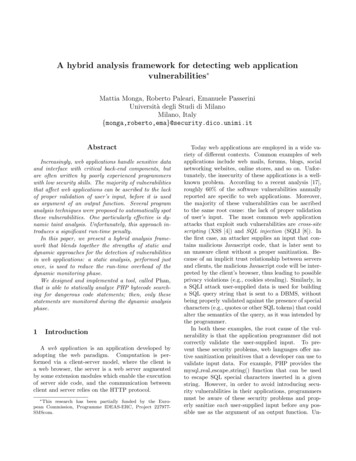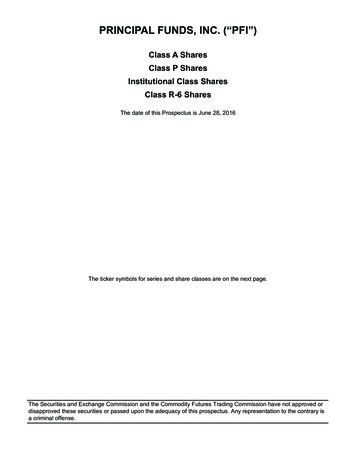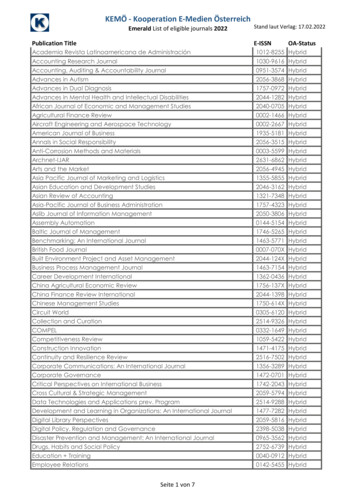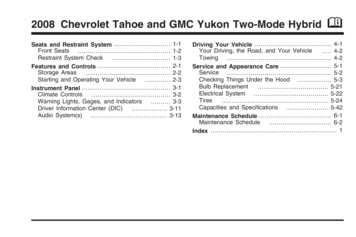
Transcription
A hybrid analysis framework for detecting web applicationvulnerabilities Mattia Monga, Roberto Paleari, Emanuele PasseriniUniversità degli Studi di MilanoMilano, tractIncreasingly, web applications handle sensitive dataand interface with critical back-end components, butare often written by poorly experienced programmerswith low security skills. The majority of vulnerabilitiesthat affect web applications can be ascribed to the lackof proper validation of user’s input, before it is usedas argument of an output function. Several programanalysis techniques were proposed to automatically spotthese vulnerabilities. One particularly effective is dynamic taint analysis. Unfortunately, this approach introduces a significant run-time penalty.In this paper, we present a hybrid analysis framework that blends together the strengths of static anddynamic approaches for the detection of vulnerabilitiesin web applications: a static analysis, performed justonce, is used to reduce the run-time overhead of thedynamic monitoring phase.We designed and implemented a tool, called Phan,that is able to statically analyze PHP bytecode searching for dangerous code statements; then, only thesestatements are monitored during the dynamic analysisphase.1IntroductionA web application is an application developed byadopting the web paradigm. Computation is performed via a client-server model, where the client isa web browser, the server is a web server augmentedby some extension modules which enable the executionof server side code, and the communication betweenclient and server relies on the HTTP protocol. This research has been partially funded by the European Commission, Programme IDEAS-ERC, Project 227977SMScom.Today web applications are employed in a wide variety of different contexts. Common examples of webapplications include web mails, forums, blogs, socialnetworking websites, online stores, and so on. Unfortunately, the insecurity of these applications is a wellknown problem. According to a recent analysis [17],roughly 60% of the software vulnerabilities annuallyreported are specific to web applications. Moreover,the majority of these vulnerabilities can be ascribedto the same root cause: the lack of proper validationof user’s input. The most common web applicationattacks that exploit such vulnerabilities are cross-sitescripting (XSS [4]) and SQL injection (SQLI [8]). Inthe first case, an attacker supplies an input that contains malicious Javascript code, that is later sent toan unaware client without a proper sanitization. Because of an implicit trust relationship between serversand clients, the malicious Javascript code will be interpreted by the client’s browser, thus leading to possibleprivacy violations (e.g., cookies stealing). Similarly, ina SQLI attack user-supplied data is used for buildinga SQL query string that is sent to a DBMS, withoutbeing properly validated against the presence of specialcharacters (e.g., quotes or other SQL tokens) that couldalter the semantics of the query, as it was intended bythe programmer.In both these examples, the root cause of the vulnerability is that the application programmer did notcorrectly validate the user-supplied input. To prevent these security problems, web languages offer native sanitization primitives that a developer can use tovalidate input data. For example, PHP provides themysql real escape string() function that can be usedto escape SQL special characters inserted in a givenstring. However, in order to avoid introducing security vulnerabilities in their applications, programmersmust be aware of these security problems and properly sanitize each user-supplied input before any possible use as the argument of an output function. Un-
fortunately, nowadays web applications are often written by developers with low programming and securityskills, that sometimes ignore programming good practice. Moreover, most applications are produced by assembling scripts coming from different developers, andit is not always feasible to review all the code base. Asweb applications are getting more and more complex,it is becoming quite difficult to be able to assert anyelementary property about their code.Several solutions have been proposed that aim atfinding automatically security vulnerabilities in webapplications [5]. Existing solutions can typically beclassified into static and dynamic approaches. Staticanalyzers [12, 11, 20, 10] consider the source code without actually executing it; their strength is that they canreason over all possible program paths, but they areoften overly conservative, since they normally reportsproperties weaker than the ones that actually hold ina specific execution. On the other side, dynamic approaches [16, 7] focus on an actual execution of the target application; they consider only a limited number ofprogram paths (i.e., those that have been covered inthe observed executions), but they can provide moreaccurate results. Unfortunately, dynamic tools introduce a significant run-time overhead in the applicationbeing analyzed.In this paper we present a system for analyzing webapplications based on a hybrid approach. Our solution blends together the strengths of static and dynamic approaches [6]. It has been implemented inan experimental prototype code named Phan (PHPHybrid Analyzer). Phan currently targets PHP applications, but can be easily extended to other environments. First, Phan statically analyzes the target application, searching for dangerous statements; afterwards,only those statements that have been found to be dangerous will be monitored dynamically, thus reducingthe run-time overhead. It is worth noting that Phandoes not work on PHP source code, but directly at thebytecode level. In fact, PHP applications are first compiled into a low-level and poorly documented bytecodelanguage that is then interpreted by Zend, the PHP underlying virtual machine. Even if dynamic approachestargeting Zend bytecode already exist [16, 7, 13], thisis, to the best of our knowledge, the first time statictechniques are directly applied to Zend bytecode.The contributions of this paper can be summarizedas follows: we present a hybrid program analysis frameworkfor detecting input-driven security vulnerabilitiesin web applications. Our solution relies on a staticpreprocessing technique to reduce the run-timeoverhead of the subsequent dynamic analyses. We describe how we instrumented Zend in order toimplement a prototype of Phan, our experimentaltool that performs static and dynamic analysis ofPHP applications, at the Zend bytecode level.This paper is structured as follows. In Section 2we motivate our work and we give a high-level viewof a hybrid analysis framework for web applications.Section 3 describes the architecture of Phan, our hybrid analyzer for PHP applications. Section 4 presentssome technical details of the experimental prototypewe built. In Section 5 we discuss the limitations of ouranalysis framework, we present some preliminary experimental results and we outline some directions forthe future. Finally, in Section 6 we discuss some relatedwork, while Section 7 briefly concludes this paper.2Hybrid analysis of web applicationsThe goal of our approach is to monitor the executionof a given web application and to intercept injectionattacks, i.e., those attacks that exploit the impropervalidation of user-supplied input data, before it is usedas argument of an output function.Our approach is made up of two distinct logic steps:(i) a static analysis of the application, that identifiesdangerous statements and (ii) run-time monitoring ofthe identified statements.Initially, we generate a static model of the wholeapplication. The application code is translated into anintermediate form. The rationale behind the choice ofour intermediate representation language was to reducethe number of instruction and expression classes, in order to ease the subsequent analyses, while still beingable to precisely capture the semantics of the application code.Then, for each program function, we build its controlflow graph (CFG) [2]. Such CFGs are connected together, thus obtaining an interprocedural CFG (iCFG),that is analyzed to individuate all possible code pathsfrom a user input source (e.g., GET, POST and COOKIE arrays in PHP) to a sensitive sink. Bysensitive sink we mean any function that could leadto security problems when executed over unsanitizeduser-supplied data (e.g., mysql query() and echo(),in PHP).Finally, from all statements appearing in thesepaths, we extract only those that might affect the input arguments of a sensitive sink. We do this by calculating, for each sensitive sink, the backward slice [19]over its input arguments. All these statements aremarked as “dangerous”. During the subsequent dynamic phase, only dangerous statements need to bemonitored.
The resulting static model is overly conservative,mainly due to limited support for aliasing and classconstructs; currently, we address these limitations byextending the number of program statements to bemonitored dynamically. In other words, we try to preserve soundness at the cost of greater run-time overhead.Dangerous statements will be used to perform an efficient dynamic taint analysis, since most of the statements have been filtered out by the static preprocessing. Data that originate or derive from an untrustedsource are marked as tainted : we start by markinginput data as tainted, and then we dynamically keeptrack of how the tainted attribute propagates to otherdata. Initially, only a minimal set of program variables are considered to be tainted (e.g., all PHP globalarrays that contain user-supplied data). As the execution goes on, other program variables become tainted.When we detect that tainted data containing maliciouscharacters has reached a sensitive sink, we can chooseeither to block the execution or to sanitize tainted databefore allowing the application to continue.It is worth pointing out that tainted values cannot be sanitized as soon as they are read from input sources; in fact, at this point, we are not surewhether untrusted variables will eventually be sanitized by the application, nor if they will ever reach asensitive sink. For these reasons, the preemptive sanitization of tainted variables could alter the originalsemantics of the target application.On-line monitoring can be very effective, but, inorder to minimize the run-time penalty, it should beconstrained to a limited number of dangerous statements. However, the identification of these code pathsrequires a priori knowledge of the structure of the program, that, without the initial off-line phase, would bealmost incomplete.In Figure 1 we report a simple PHP script1 thatchecks whether the user has supplied a product ID asa GET parameter of the HTTP request (line 7); inthis case, a SQL query is built to extract the information about the specified product from the underlyingMySQL database (line 2). This script contains a SQLIvulnerability: since the user input is not properly sanitized, an attacker could manipulate the query submitted to the DBMS (line 4). This example will be usedin the following to illustrate our approach.function get product( id) { q ”SELECT . WHERE id id”;3mysql connect(.);4 res mysql query( q);5 }12678910111213Figure 1. Sample PHP code fragment with aSQLI vulnerability.3Phan: a hybrid analyzer for PHP applicationsIn this section we describe how the high-level solution introduced in Section 2 can be applied to PHPcode. To this end, we present Phan, our hybrid analysis framework for PHP applications. Phan does notrequire any modification to the source code of the target application, nor any interaction with web application developers. All the static and dynamic analysesperformed by Phan are carried out directly on Zendbytecode. We adopted this strategy in order to avoidthe intricacies of parsing PHP: the bytecode has 150opcodes, and it is pretty stable among PHP releases.Phan is organized into the two following main components:1. an off-line analysis engine, that translates Zendbytecode into an intermediate form, constructsa control flow graph for each program function,merges together the CFGs into a single interprocedural CFG, and finally identifies dangerous program statements;2. an on-line monitoring engine, that performs dynamic taint tracking on Zend bytecode, and reactsproperly when tainted user-supplied data reachesa sensitive sink.Each of these components is described into more details in the following sections.3.11 Phan deals with Zend bytecode, however, for the sake of clarity, the example is shown in its source code form.if(isset( GET[’product id’])) { a GET[’product id’];get product( a);} else { msg ’Invalid request’;echo msg;}Off-line analysisThe goal of this phase is to provide a conservativeview of the whole application, that will be used to drive
the on-line analysis to a limited number of programstatements. It is worth pointing out that the off-lineanalysis has to be done just once for each applicationscript, and has not to be repeated every time a userrequires the execution of a PHP script. In this section,we describe the steps involved in the off-line analysisof a single application script. The same steps have tobe carried out for each script in the target application.Translation into intermediate representation.First of all we had to instrument Zend, in order intercept the compilation of PHP scripts. In this way,we are able to obtain a bytecode representation ofeach application script. To ease the analysis, bytecode instructions are translated into a simple intermediate representation (IR). Our IR resembles a RISClike assembly language, including just 5 instructiontypes (Assignment, Call, Ret, Jump and Nop) and4 expression types (Constant, Variable, Array, andCompoundExpression; the last one is used to modelunary, binary and ternary expressions). For each intermediate instruction, we also compute the set of usedand defined variables [1]. The translation of Zend bytecode into IR language has required a significant engineering effort: each opcode supported by the Zendvirtual machine has to be precisely modeled using ourRISC-like language, in order to capture the exact semantics of the application being analyzed. If an application script includes additional modules, each ofthem is recursively compiled and translated into IRlanguage. In this way, we obtain a complete and selfcontained (except for PHP native functions) view ofthe PHP script.The example in Figure 1, when compiled by Zend,includes 24 opcodes, and is then translated into 33 intermediate instructions.CFG construction. We briefly recall that a controlflow graph (CFG) is a directed graph C (B, E),where B is a set of nodes and E B B is a setof edges [2]. In our context, CFG nodes represent basicblocks, i.e., sequences of intermediate instructions witha single entry point and a single exit point. Each graphedge (bi , bj ) B indicates that the execution can flowfrom basic block bi to bj ; we say that bj is a successorof bi , and bi is a predecessor of bj .Let S {P1 , P2 , . . . , Pn } be a PHP applicationscript, where each Pi is a program procedure, and P1is the “main” procedure of S (i.e., P1 is the first codesequence that gets executed when S is invoked). Webuild the CFG of each procedure Pi S using standard techniques [1]. We inspect each CFG searchingfor indirect control transfer instructions. Indirect con-trol transfers are handled using constraint propagationand reaching definition analysis [14]. We have now aset of CFGs C {CP1 , CP2 , . . . , CPn }, where CPi is thecontrol flow graph for program procedure Pi . Then, inorder to generate an interprocedural CFG (iCFG) ofS, we combine together the CFGs in C in the followingway. For each instruction i S, if i is a call to a userdefined function Pi , let bi be the basic block i belongsto, and let bj be the successor of bi ; then, we removefrom the iCFG the control flow edge (bi , bj ) and weadd two edges (bi , bentry ), (bexit , bj ), where bentry andbexit are the entry and exit points of CPi , respectively.Similarly, if i is an inclusion statement (i.e., include(),include once(), require(), or require once()) thatincludes the PHP script S 0 , then we replace the controlflow edge (bi , bj ) with two edges (bi , b0entry ), (b0exit , bj ),where b0entry is the entry point of CP10 and b0exit is itsexit point.if(isset( GET['product id']))truefalse a GET['product id'];get product( a); msg 'Invalid request';echo msg; q "SELECT . WHERE id id";mysql connect(.);mysql query( q);exit()Figure 2. Interprocedural control flow graphfor the PHP code fragment in Figure 1.In Figure 2 we show the interprocedural CFG of theexample described in Figure 1. To build the iCFG, wemerged together the CFG of the “main” procedure withthe CFG of get product(): the basic block containingthe function call to get product() is connected with theentry point of the called procedure.
Identification of dangerous statements. The offline analysis terminates with the identification of dangerous code statements. We analyze the iCFG andwe identify all input sources and sensitive sinks. Input sources correspond to those PHP superglobal variables2 that allow an application developer to read usersupplied data (e.g., GET, POST, COOKIE and REQUEST). In order to prevent second-order injection attacks, we should also consider the output arguments of functions that read data from a database orthe filesystem as sensitive data sources. However, notall data coming from these sources was originally supplied by the user. For this reason, we excluded thisfeature from our current implementation, as we havenot investigated yet how to handle the false positivesthat could arise from this design choice.Sensitive sinks correspond to those functions thatmight send malicious data back to the user (e.g.,echo() and print()) or to the underlying DBMS (e.g.,mysql query()). Through the application of standarddata-flow analyses on the iCFG, we are able to ignorethose sink function calls that are guaranteed to receiveas input only constant arguments. Then, we use agraph traversal algorithm to identify all possible codepaths from an input source to a sensitive sink. Dangerous statements are identified by extracting from thesepaths those statements that might affect an input argument of a sensitive sink. Let i denote a sensitive sink,and let W be the set of program variables that represent the input arguments of i. We identify dangerousstatements by computing over the iCFG the backwardslice for the slicingcriterion (i, W ). We first computeSthe set H w W srd(w, i), where srd(w, i) represents the static reaching definitions for variable w atprogram point i. Then, as described in [9], we can reduce our problem to the computation of the set L ofprogram statements that are reachable in the data dependence graph of the analyzed program, starting froma statement in H. Dangerous statements are all thosestatements included in L that also appear in a codepath that connects an input source with a sensitivesink.In the example reported in Figure 1 the only input source is represented by the GET array, used atlines 7 and 8. We have two different sensitive functions:mysql query() (line 4) and echo() (line 12); however,constant propagation analysis reveals that the only input argument of echo() is a constant value, thus thisfunction is not considered as a sentive sink. In Figure 2 we depict with a solid border the basic blocksthat appear in a code path that connects an input2 PHPsuperglobals are built-in global variables that are always available in all scopes.source with a sensitive sink. The backward slice forthe slicing criterion (4, { q}) includes only source lines{8, 9, 2, 4}; these are the dangerous statements whosecorresponding Zend opcodes will be monitored in theon-line phase.3.2On-line analysisDuring the on-line analysis phase we perform a dynamic taint analysis on Zend bytecode. Initially, onlythe input sources are marked as tainted. We modifiedthe Zend virtual machine to guarantee the correct propagation of taint information during program execution;only dangerous code statements are dynamically monitored. When a function corresponding to a sensitivesink is invoked over tainted malicious characters, wecan choose either to abort the execution or to sanitizethe input before allowing the function to continue.Taint meta-information. We modified the Zendvirtual machine to keep track of the taint metainformation connected to string variables. Zend associates to each variable x a zval structure, updated during the execution to reflect the current value of x. Weaugmented the zval structure by including taint metainformation. In particular a list of (index, labels)pairs is associated to each string variable, where indexdenotes a specific string character, while labels is abit vector that specifies which taint labels are associated to that element. Taint labels allow us to preciselytrack which input sources affect a tainted program variable. In our architecture, taint meta-information isprotected from unauthorized modifications by the isolation provided by the Zend virtual machine: as long asan attacker cannot tamper the virtual machine, taintmeta-information cannot be altered.Propagation of taint meta-information. To ensure the correct propagation of taint meta-information,we had to modify the implementation of string-relatedfunctions inside the Zend virtual machine. We alsoinstrumented Zend’s internal functions that manipulate zval operands, propagating taint information fromsource operands to destination.Phan is able to perform fine-grained tracking oftainted meta-information: as taint propagation is performed with character-level granularity, we can precisely handle also program statements that directly manipulate strings as character arrays.Detection of injection attacks. When programexecution reaches a sensitive sink, we check whether thesink function is going to be invoked over tainted input
arguments. To each sink function, we associate an “oracle” procedure that determines if a particular taintedstring exploits the vulnerability associated to that specific sink. In order to detect exploitation attempts, ourcurrent implementation of the oracle functions leverages well-known attack techniques. As an example,the oracle associated to the mysql query() procedureperforms limited syntactical analysis of the SQL querythat is going to be sent to the database, searching fortainted characters in unsafe positions (i.e., we searchfor tainted characters that could alter the original semantics of the query statement).4Implementation detailsWe have implemented Phan in an experimental prototype that extends PHP 5.2.6. The off-line analysismodule consists of 6000 lines of Python code and 1500 lines of C code for interfacing with the Zendvirtual machine. The on-line engine consists of 1000lines of C code.The off-line analyzer has been realized as a PHPextension module that hooks Zend’s compilation routine. After Zend has successfully compiled a source file,the extension sends its bytecode representation to thePython module, that translates it into the intermediate language and performs the analyses described inSection 3.1. The final outcome is the set of dangerousopcode statements that have to be monitored at runtime. Our current implementation is still not complete,as we currently supports 93 out of 150 Zend opcodes.For performance reasons, the on-line analyzer is entirely written in C. We had to install a limited number of hooks inside the Zend virtual machine, but themajority of the taint propagation code is encapsulatedinto a self-contained module. By limiting the number of modifications to Zend’s source code, we tried tominimize the burden of work required for porting theon-line engine to different versions of PHP.5DiscussionLimitations and future work. The current versionof Phan has some limitations, that we briefly summarize in this paragraph together with possible directionsfor future work.The off-line engine can be significantly improved byintegrating a static taint analysis module [11], thatcould further reduce the number of program statementsto be monitored dynamically. Moreover, the currentstatic analysis engine has limited support for aliasingand class constructs. In the current implementation,we address these limitations by dynamically monitoring all those code regions that we are not able to analyze statically. Finally, Phan assumes the output of asanitization routine to be untainted, without even considering that the sanitization process implemented bythe application developer could be incorrect or incomplete. At this end, we could use the approach describedin [3] to verify the correctness of the input sanitizationprocess.Preliminary evaluation. Table 1 presents somepreliminary experiments we accomplished over a setof open-source PHP applications. For each application, we report the vulnerability type, a reference to thevulnerability description, the total number of Zend opcodes (i.e., Zend bytecode statements) in the monitoredapplication script, the total number of Zend opcodesthat appear along code paths that connect sources tosinks, and the number of dangerous opcodes. In thelast column, we report the percentage of dangerous opcode with respect to path opcodes. As path opcodesrepresent a lower bound to the number of opcodes monitored by a fully dynamic approach, this percentage isa good approximation of the performance gain comingfrom a hybrid analysis solution. Moreover, we believethe improvements sketched out in the previous paragraph might further decrease the number of dangerousopcodes, and thus reduce the run-time overhead of thedynamic phase.6Related workExisting solutions for the automatic detection of security vulnerabilities in web applications can be classified into two broad categories: static and dynamicapproaches.Static approaches. Many different approaches havebeen proposed for statically detecting security vulnerabilities in web applications. Huang et al. proposedWebSSARI [10], a lattice-based static analysis algorithm for the intra-procedural analysis of PHP programs. WebSSARI is derived from type systems andtypestate, and it does not track the value of stringvariables; this can lead to a high false positives rate.In [12, 11], Jovanovic et al. present Pixy, a static analysis tool that performs flow-sensitive, interproceduraland context-sensitive data-flow analysis on PHP applications. Pixy is quite efficient and precise, with a lowfalse positives rate. Finally, in [18] the author proposea fully automated static technique for detecting SQLIvulnerabilities in PHP programs. Their approach consists in approximating possible queries that the appli-
ApplicationClean CMS 1.5Goople CMS 1.8.2MyForum 1.3Pizzis CMS 1.5.1W2B ferenceCVE-2008-5290Bugtraq ID 33135Bugtraq ID 31926Bugtraq ID 33173Bugtraq ID 33001CVE-2008-5278Opcodes221621102911078612Path opcodes104586513881426Dangerous opcodes56 (53.85%)17 (29.31%)141 (21.66%)11 (28.95%)221 (27.15%)10 (38.46%)Table 1. Preliminary evaluation.cation could submit to the database using context freegrammars; then, they track how input coming fromthe user can influence these grammars. However, boththese approaches do not support several features of thePHP language, most notably classes and dynamicallygenerated code. In Phan, we address these limitationswith our on-line analysis engine.Dynamic approaches. Probably, the first approachthat employed dynamic techniques for the taint analysis of applications is Perl taint-mode [15]: the interpreter prevents the use of user-supplied data that hasnot been explicitly sanitized.The works presented in [16, 13] are very close to ouron-line engine. Both solutions protect PHP applicationagainst injection attacks using taint analysis, with anaverage run-time overhead of 10%. Unfortunately,both these works propose a fully dynamic analysis solution; we believe a hybrid approach like the one discussed in this paper can further reduce their run-timeoverhead. Moreover, the taint propagation performedby CSSE [16] is too coarse-grained, as it is not able topropagate taint meta-information when character-levelstring operations are performed; Phan offers a morefine-grained taint tracking solution.7ConclusionsIn this paper, we presented an approach for detecting injection vulnerabilities in web applicationsthrough hybrid analysis techniques. Our proposalblends together the strengths of static and dynamic approaches: the preliminary static analysis phase helpsreducing the run-time overhead connected with dynamic monitoring. We described the design and implementation of Phan, a hybrid analyzer for PHP applications that works directly at the Zend bytecode level.The preliminary results indicate that the improvement with respect to a taint analysis entirely dynamicis significant. Thus, we plan to further increase the accuracy of our analysis in order to evaluate our solutionin extended examples.References[1] A. V. Aho, R. Sethi, and J. D. Ullman. Compilers,Principles, Techniques, and Tools. Addison-Wesley,1986.[2] F. E. Allen. Control Flow Analysis. SIGPLAN Notices, 5, 1970.[3] D. Balzarotti, M. Cova, V. Felmetsger, N. Jovanovic,E. Kirda, C. Kruegel, and G. Vigna. Saner: Composing Static and Dynamic Analysis to Validate Sanitization in Web Applications. In Proceedings of theIEEE Symposium on Security and Privacy, Oakland,CA, May 2008.[4] CERT. Advisory CA-2000-02: Malicious HTML TagsEmbedded in Client Web Requests, 2002.[5] M. Cova, V. Felmetsger, and G. Vigna. VulnerabilityAnalysis of Web Applications. In L. Baresi and E. DiNitto, editors, Testing and Analysis of Web Services.Springer, 2007.[6] M. D. Ernst. Static and Dynamic Analysis
A hybrid analysis framework for detecting web application vulnerabilities Mattia Monga, Roberto Paleari, Emanuele Passerini Universit a degli Studi di Milano Milano, Italy fmonga,roberto,emag@security.dico.unimi.it Abstract Increasingly, web applications handle sensitive data and interface with critical back-end components, but











